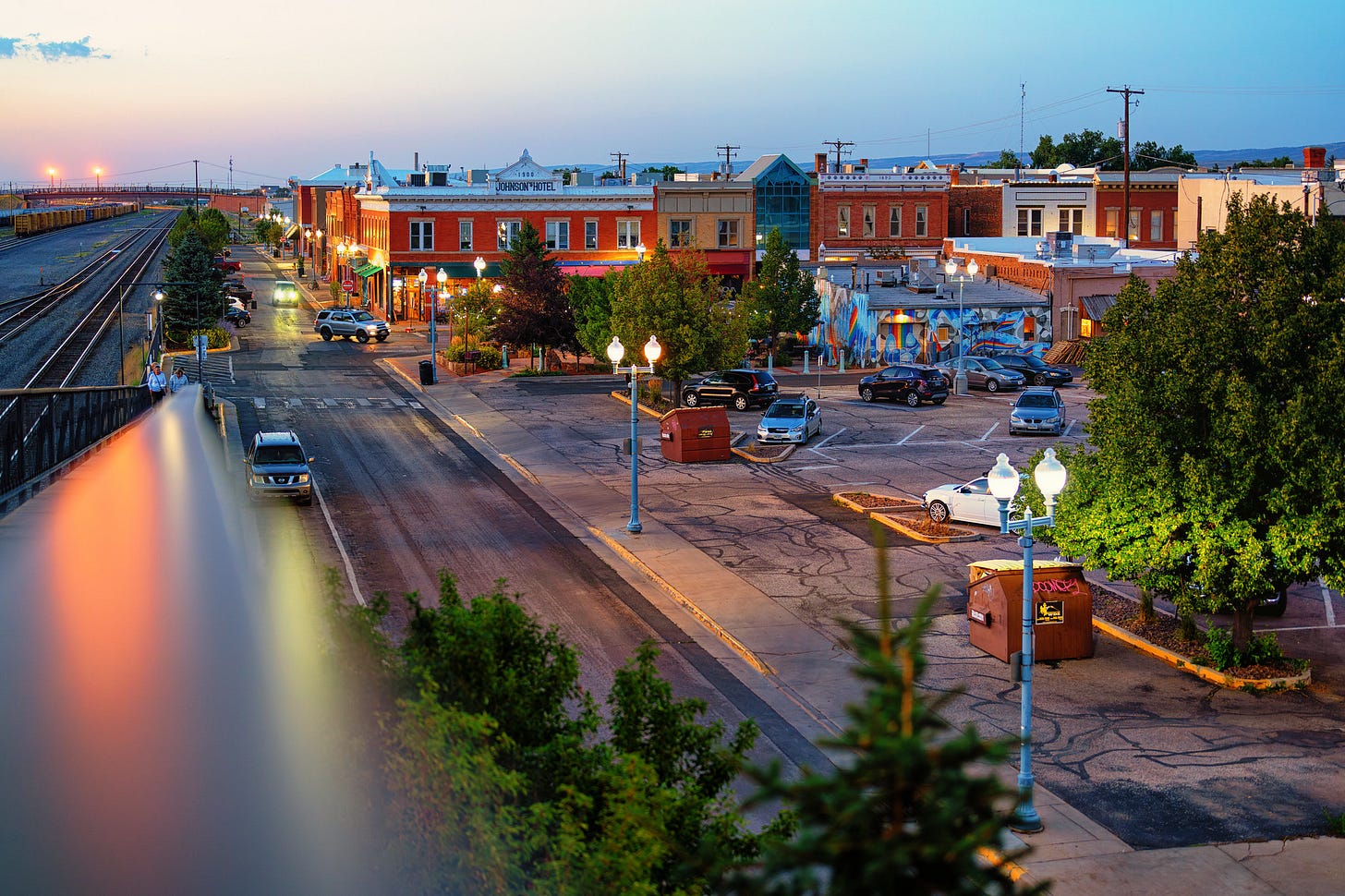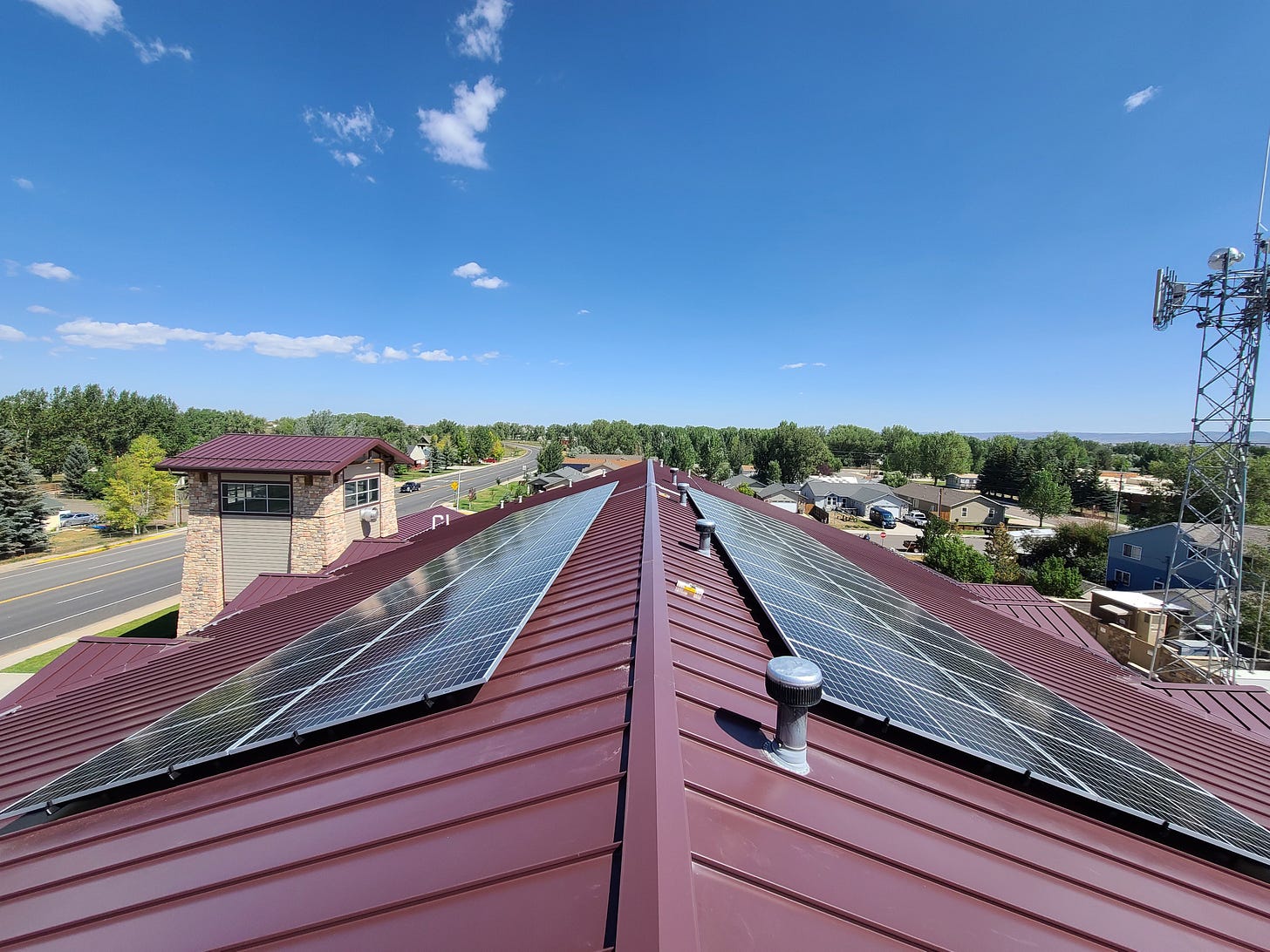Laramie’s new Emissions Reduction Plan outlines path to carbon neutrality
The city is aiming for net-zero by 2050. The plan recommends both short- and long-term goals regarding energy use, vehicles, and the city’s largest source of municipal emissions: the Laramie Landfill.

The city of Laramie is capable of achieving carbon neutrality for municipal operations by 2050, according to the Emissions Reduction Plan approved by the Laramie City Council this week.
The plan recommends retrofitting buildings for greater energy efficiency, installing more rooftop solar energy rigs, gradually replacing the city’s fleet of vehicles with hybrid or fully electric alternatives, and addressing the largest source of municipal emissions: the Laramie Landfill north of town.
The unanimous vote from councilors was met with an eruption of applause from the audience, many of whom were there to speak in favor of the plan, its underlying goals and what it meant for the generations to come.
“I want to be able to enjoy being outdoors long into the future,” said Annika Murthy, a third grader attending Slade Elementary School. “I want to keep playing on swings and climbing mountains to make me stronger. When I grow up and have kids I want them to be able to enjoy the outdoors too. This plan will help to protect Laramie’s beautiful outdoors that I love.”
Since the industrial revolution, the release of carbon dioxide and other greenhouse gasses into the atmosphere have altered the climate of humanity’s only home. Those gasses have blocked and continue to block increasing quantities of energy from dissipating back into outer space, thereby warming the planet, melting its ice sheets, and raising sea levels. The result is more severe, frequent and chaotic weather events that have threatened human security around the world.
“The state of Wyoming is projected to experience increased risks to public health as a result of severe weather, including a greater frequency of extremely hot and cold days,” the Emissions Reduction Plan states. “Specifically, by 2050, Wyoming is likely to have twice as many days above 100°F as it has today. The City of Laramie, in particular, is considered to be at “high” heat risk, and is projected to experience 36 hot days per year (i.e., days above 86°F) by 2050, as opposed to [the] 7 hot days per year that it traditionally experiences.”
The plan further notes that:
“Depending on future emissions scenarios, annual average daily temperatures in Albany County are projected to increase between 5.8° F and 10.7°F by the end of the century.”
While no region of Wyoming will be left untouched by climate change, Albany County stands to get much drier, increasing the risk and prevalence of drought and wildfire.
No one community or individual can reverse this global trend, but both communities and individuals across the globe have taken action — planning, inventing and protesting for a multi-faceted variety of solutions geared toward drawing down humanity’s carbon emissions.
“Municipalities have control over building design, land development, transportation, waste management, and more within their jurisdictions, all of which contribute to local energy use and emissions,” the plan states. “Local governments, relative to their federal and state counterparts, are highly connected to their constituents on a microscale. Often, this allows local governments to be responsive to community-specific opportunities and constraints, including those relevant to climate change.”
For the Laramie city government, that has meant pushing for solar installations and chasing ever greater energy efficiency.
On Tuesday, it meant passing the Emissions Reduction Plan, which details Laramie’s greatest sources of CO2 emissions and outlines what the municipality must do to reach its targets — a 50 percent reduction in emissions by 2030, a 90 percent reduction by 2040, and full carbon neutrality by mid-century.
Putting the plan into action
Corrine Scieszka, a University of Wyoming graduate research assistant, worked with the city to inventory Laramie’s emissions, investigate possible actions and craft recommendations for how the city can reduce its carbon footprint.
“We’ve completed the discovery phase, we’ve completed our greenhouse gas inventory — which I had presented on previously — and we’re now in the planning phase, which leads us to the creation of the Emissions Reduction Plan,” Scieszka told the council. “The emissions plan is not meant to be a mandate, but rather a framework to guide the selection of projects in pursuit of pre-established mitigation goals.”
Scieszka said the council must now take the plan and begin an “iterative” process of deciding on specific actions, budgeting for them, and working to complete them.
Crucial to this process is understanding exactly where the city is emitting the most carbon dioxide. Scieszka’s inventory revealed:
Solid Waste Facilities produce 46,343 metric tons of carbon dioxide-equivalent
Building and Facilities produce 7,322 metric tons of carbon dioxide-equivalent
City vehicles produce 1,015 metric tons of carbon dioxide-equivalent
Waste and Wastewater Treatment produces 270 metric tons of carbon dioxide-equivalent
Employee Commutes produce 158 metric tons of carbon dioxide-equivalent
Scieszka said it is not typical for a city’s landfill to be the greatest source of emissions; that distinction typically belongs to buildings and operations. But Laramie is not a typical city. Only 48 percent of the garbage finding its way to the city’s landfill originates within Laramie.
It also accepts trash from communities that don’t have their own dedicated landfill for residential garbage, such as Saratoga and Elk Mountain, as well as some rural communities in far northern Colorado.
The plan recommends, in the near-term, working to understand the landfill better. It says the city should collect waste characterization data, which could inform diversion programs. Currently, the exact mix of materials winding up in the landfill is not well understood and city staff use national averages to estimate it.
In the long-term, the plan notes there could be opportunities to install gas capture technologies, perhaps through the EPA’s Landfill Methane Outreach Program, but Laramie currently doesn’t produce enough trash to qualify.
“To be considered a candidate for such a [gas capture] system, the EPA recommends that 1 million tons of waste be in place,” Scieszka said. “The Laramie Landfill currently has around 904,000. In fiscal year 2022, though, 43,000 tons of waste were generated. So we don’t meet the threshold as of now, but it’s very likely that we will surpass that in the future. And so the plan calls to reassess the viability of such a system in the longer term.”
The landfill’s annual release of 46,000 metric tons of CO2-equivalent is still high, but emissions from the landfill have been falling steadily since peaking at close to 98,000 in 2020, according to city statistics.
Laramie’s city-owned buildings and facilities are another large source of emissions. The installation of solar panels through Rocky Mountain Power’s Blue Sky Grant Program has started to chip away at these emissions, but Scieszka noted more should be done.
“As mentioned, the city has already successfully implemented a number of various solar projects onsite and the plan calls for continuing to pursue onsite solar installations where feasible,” she said. “However, the majority of local governments, including Laramie, lack sufficient space to implement adequate onsite solar installations capable of powering all municipal operations. So this gap can be addressed through leasing of local land and/or off-site purchasing of clean energy sources.”
This could involve collaborating with utilities, power purchase agreements or renewable energy credits, Scieszka said. Laramie’s buildings and facilities will also produce fewer emissions as the grid itself is fed more and more by renewable energy sources like wind and solar. Both Black Hills Energy and Rocky Mountain Power’s parent company Pacificorp have net carbon reduction commitments set for the upcoming decades.

The reduction plan also recommends integrating electric and hybrid vehicles into the city’s fleet. This is already an avenue of emissions reduction the city is pursuing, and Scieszka suggested this continue on a gradual basis, as current vehicles age out of usefulness.
“I want to be clear that the plan is not recommending replacing functional vehicles with an all-electric fleet,” she said.
Where replacement is not yet feasible, city staff can also increase efficiency by optimizing routes, keeping tires inflated, changing oil and replacing air filters regularly.
Even if the city pursues each objective outlined in the plan, some carbon emissions will remain. The plan outlines where those remaining emissions might be and notes the city should consider offset and sequestration as strategies for hitting net-zero.
“Inevitably, over the course of implementing projects to meet emissions reduction goals, there will likely be remaining municipal emissions at the end of the process that cannot be removed,” the plan states. “As such, sequestration of carbon from the atmosphere by greenspace in the City of Laramie, as well as other offset options, can serve as supplementary strategies to those previously outlined.”
The plan can be read in its entirety here. Scieszka’s presentation, with the plan’s key findings and recommendations, can be found here.
Community backing
A triumphant mood infused the council chambers Tuesday as public commenters lauded the plan.
“I’m proud to live in a place where its community members think seriously about the impacts that climate change and sustainable resource use will have on my generation and the generations to come,” said Emma Jones, a student at the University of Wyoming. “We’ve already seen the impact that climate change has on the health of our natural resources and communities. But I think we can also very clearly see the practical positive impact that this type of plan will have on the people who live here.”
Young people have the most to gain from climate action, but they’re not the only ones. Nor is the struggle for environmental protection a new one, as Sarah Gorin reminded the council.
“I’m old enough to remember the passage of landmark environmental legislation like the Clean Air Act and the Clean Water Act back in 1970 and 1972,” she said. “And passage of those laws was precipitated by things like rivers catching fire — I mean, we were in a state at that point — and still, the opposition to those laws and regulations that followed was stiff.”
Gorin said the arguments against action back then — about the costs, about the technology, about the unintended consequences of acting — mirror the arguments lodged against taking action today.
But at the council meeting Tuesday, the voices of “New Climate Denial” were not present.
The council approved the plan with a unanimous vote, though two councilors were absent. The plan is not binding, but seeks to direct council attention, proposals and goals across the next quarter century.
Laramie is currently participating in both the International Council for Local Environmental Initiatives, commonly known as ICLEI, and the Mountain Towns 2030 Solutions Project.
“In these ways, cities and counties across the country have become important leaders in the national and international climate change conversation, as they serve as centers of innovation and are implementers of context-based climate solutions,” the emissions reduction plan notes. “While localities such as Laramie have relatively small contributions to global greenhouse gas emissions, they have the opportunity to lead the way in the development of equitable, climate-resilient, and sustainable communities.”





Glad to see Laramie trying to be proactive on this. I wonder if more recycling might reduce emissions at the landfill?